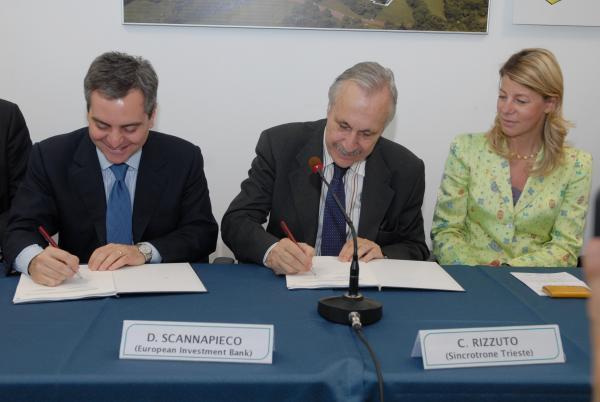
The European Investment Bank (EIB) today signed a EUR 20m finance contract with Sincrotrone Trieste for the completion and launching of the new FERMI@Elettra light source. The Bank was represented by Dario Scannapieco, EIB Vice-President responsible for operations in Italy, Malta and the western Balkans, and Sincrotrone Trieste by its Chairman Carlo Rizzuto and CEO Alfonso Franciosi.
FERMI@Elettra is based on a newly designed free-electron laser for studying materials, which as an international laboratory will be open to the scientific community and to companies.
The EIB loan will cover 50% of the cost of the final phase of the project. With the new source, which will enter into operation in 2011 and complement the Elettra syncrotron’s light source (inaugurated in 1994), Sincrotrone Trieste intends to establish itself over the next few years as one of the major players in Europe and globally in the study of surfaces and new materials at the atomic and subatomic level.
Sincrotrone Trieste is a joint stock company established in the form of a consortium in which Area Science Park has a controlling interest (with 51% of the shares), the other shareholders being the Region of Friuli-Venezia Giulia (40%), CNR (5%) and Invitalia (4%).
The EIB finance for Sincrotrone Trieste will also cover the cost of completing the tri generation plant for supplying the new laboratory, which will double the efficiency of the energy used compared with a conventional plant.
"With this project, the EIB and the European Union confirm their commitment to financing advanced research. This type of investment is crucial for the technological and social progress of our economies. The Trieste synchrotron is a project in which the EIB firmly believes. The EIB was involved in financing it years ago and is now supporting this expansion phase, convinced that, as in the past, the scientists working on this new research venture will also be able to come up with important practical applications that will promote economic growth", commented Mr Scannapieco.
“The assistance provided by the European Investment Bank and the European Commission”, added Mr Rizzuto, “as well as confirming the importance of Sincrotrone Trieste in the field of international research, marks another step towards the creation of a European area for research and innovation. This has also been achieved via instruments that have been made possible by the establishment of an area that has been strengthened by the introduction of the common currency. In this European system Italy has – and will continue to have – a key role to play”.
Background information:
EIB
The European Investment Bank supports the policy and strategic objectives of the European Union by granting long-term loans for economically viable projects. The EIB’s shareholders are the EU’s 27 Member States. Italy is one of the four major shareholders, together with the United Kingdom, Germany and France (each holding 16.2% of the capital). New financing operations in 2009 totalled around EUR 80bn, of which EUR 9.7bn went to Italy. At the end of 2009 the total amount of finance outstanding in Italy stood at over EUR 50bn.
Elettra and FERMI
Elettra, which has been operating for 16 years but is constantly being updated, is a storage ring with a circumference of 260 m in which electrons, accelerated to a speed close to that of light, generate ultra-bright beams of light covering all frequencies from infra-red to X rays. These ultra-bright beams are then used to analyse, in atomic detail, the structure and internal operation of materials in a number of fields (electronics, environmental sciences, materials engineering, medicine and nanotechnology).
FERMI@Elettra, which works in cooperation with Elettra, is a light source based on a linear accelerator and is about 350 m long. It will produce light impulses 10 billion times brighter but also shorter than Elettra’s, which will enable a series of images to be generated of the dynamic structure of materials (50 per second), each recorded on a time scale of the order of a ten thousandth of a billionth of a second. It will thus enable chemical and physical phenomena and interactions to be studied dynamically in unprecedented detail.
Thanks to the new laboratory, Sincrotrone Trieste, which has so far already attracted thousands of researchers and companies from dozens of countries from all over the world, will be able to further develop its activities – not only in terms of basic research (on average over 200 papers are published annually on the basis of studies carried out at the laboratory in Trieste) but also, and above all, in the field of applied research. The free-electron laser, which will be made available to public institutes, research groups and private researchers, will in fact provide a unique resource for analysing and developing new products and manipulating surfaces at the microscopic level.

Photographer: EIB ©To be defined
Download original